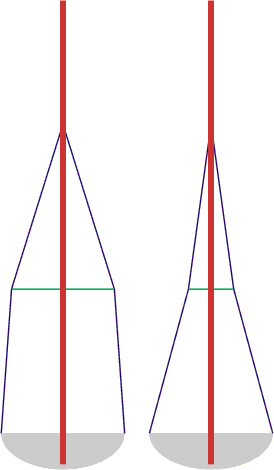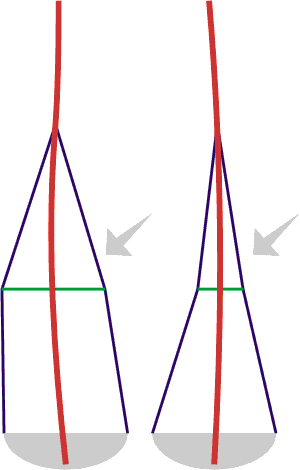|
 |
Almost all the IOM's I've seen have spreaders whose length is around 66%
of beam, like the boat on the left side of the diagrams. The boat on
the right of the diagrams shows a rather different idea, spreaders whose
length is around 45% of beam. The diagram exaggerates this for
illustrative effect, as they say.
The conventional spreaders do an excellent job of triangulating the
mast and stiffening it up, so when the boat is heeled the mast stays
reasonably upright. Conventionally, the spreaders are wider than 50%
of beam, so that they make a larger angle between shroud and mast at the
hounds. This larger angle allows the shrouds to run with somewhat
less tension than would otherwise be needed to keep the mast upright, and
is important for full-size yachts and dinghies, where people's safety is
an issue.
The "short" spreader idea has little going for it when the
boat is sailing in light airs, but the picture changes when the wind gets
up, as illustrated in the diagram on the right.
With conventional spreaders, as the boat heels and the wind fills the
main, the weather shroud tightens up and the leeward shroud
slackens. The tighter weather shroud pushes the spreader, and hence
the mast, to leeward, which is what the mainsail wants to do anyway.
The end result is that, as the old salts will tell us, "the slot
closes", and we might say that the angle of attack of the main
increases and its twist decreases. None of these things is what we
really want when the wind gets up. |
 |
With the "short" spreader, we have the opposite effect when
the wind gets up. The weather shroud tightens up, but instead of
pushing the mast to leeward, it stabilises the mast or even pulls it to
weather slightly, depending upon spreader length chosen. In any
case, the slot opens, the centre of the mainsail reduces its angle of
attack to the wind and it twists off. In theory, this is all good
news, the right response to a rising wind or a gust.
I'm trying this theory at the moment, and so is Trevor
Bamforth. His experience, he tells me, is very promising. I
saw his "Stealth" sailing at Poole in top-of-B-rig conditions,
and he won most races by half a leg of the course against very respectable
opposition. My experience in top-of-A-rig conditions is also
promising. There are a couple of things to watch. The most
important is that the mast is no longer so well stabilised against a
twisting force, and a really strong gust could pop a pre-bent mast into a
reverse bend. Ouch! It might be worth fitting a longer than
normal backstay crane to help out here, and then positively fixing the
crane to the head fitting with a screw. Oh, and keep an eye on the
IOM Class Rules when you fit the spreader. It may well need a
different method of attachment to the mast from the conventional, and we
don't want anything that won't pass measurement. |
Gary Cameron has made these suggestions in a post on the
WindPower discussion forum on or around 6/7 Oct 2001:
I think it is worth thinking about the rigs and what happens
in the gusts as our group has found that more improvements have been made in
boat speed via rig development than hull development. Jib pivot position as
well as forestay tension (provided via the backstay and mast) have a large
effect on when the jib leach opens under wind pressure alone (eg takes over
from the jib leach line, topper, whatever you want to call it). If this opens
too early you do get weather helm. But you do want it to open. As the
wind builds you need it to open in concert with the main leach opening. If you
look at an IOM rig there are two types I normally see. One is the style you
see on many UK boats with the shrouds attaching to the mast at the same height
as the forestay, long spreaders, a lot of forward mast prebend and then a lot
of backstay tension. The GBR rigs frequently have the jib pivot a long way aft
on the jib boom. This style of rig is quite "bound up", as the
forestay tension in combination with the aft position of the jib pivot
minimises the ability of the headsail to twist open in the gusts. The long
spreaders with high shroud attachment limit the middle of the mast moving to
windward, preventing the middle of the main leach opening. The top portion of
the mast does move to leeward in the larger gusts helping to de-power these
rigs. The other rig is the type you see on a TS2 or one of Trevor Bamforth's
or Geoff Smale's boats. These rigs have the shrouds attaching to the mast well
below the forestay attachment point, they use shorter spreaders with less
forward mast prebend, and usually have the jib pivot forward of the UK rigs
position. Craig Smith, Geoff, Trevor and myself all use this style of rig to
encourage the mast to move to windward in the middle (only slightly) and to
get the tip to lay off to leeward. The trick is to get this happening at the
same time the headsail leach is starting to open. Too much mast bend too early
means a loss of power and height and maybe even some lee helm creeping in. Too
little and you will get weather helm. Get it right and you go fast with a boat
that is easy to sail. If you have a TS2, follow the rigging guide. If you
don't, the principles still apply, just persist and ask for help from other
good sailors using that type of rig. Mind you, Craig and I are still learning
about the rig even after 8 years of using it. Geoff and Trevor are both good
to talk to if you get the chance.
To go with the idea of short spreaders, I've come up with some
crude adjustable spreaders to allow the "V"
angle to be changed relatively easily.
2005-12-18 |
